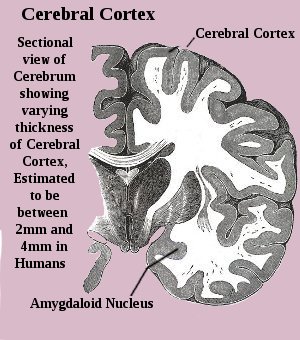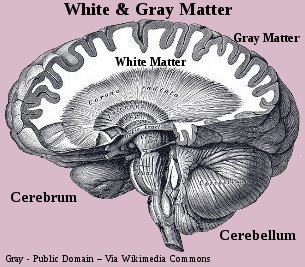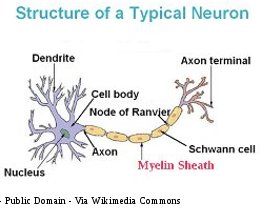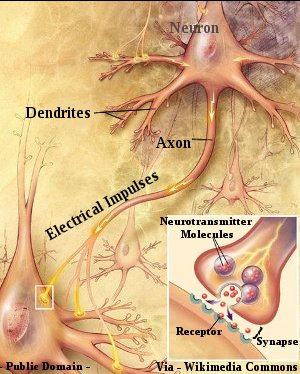The Human Brain Structure Vindicates Nature's
Engineering Ability
Part 4 - Part 3
More Major Components Of The Human Brain Structure
Continuing our Human Brain structure tour, we get to meet more components of Nature's Masterpiece. She is ever ready to impress and satisfy the inquiring mind.
Cerebral Cortex
The Cerebral Cortex is the pink colored, outer-most layer, or crust, of the two Cerebral Hemispheres composing the Cerebrum.
The Human Cerebral Cortex forms a Convoluted configuration. This form consists of Gray Matter, and is thicker in the Human Brain structure than it is in other animals. Also, Neurons can be more densely packed in the Human Cerebral Cortex than in most other creatures.
It is worth taking note that a small number of our fellow creature's Brains, such as Elephants and Whales, are not too far behind the Human Brain in Neuron density.
Accounting for approximately forty percent of the Brain mass weight-wise, the Cerebral Cortex is subdivided into areas, and labeled with their own designation of Cortex.
Subdivisions are designated according to their currently determined function, such as Motor Cortex, or Visual Cortex.
Not always appreciated as such, by certain members of our species, the Cerebral Cortex is considered to be the seat of Intelligent Behavior. This absorbing component of our Brain has connections, via our Central Nervous System, to every part of our Body.
Cerebellum
Our so called Mini Brain, the Cerebellum, resides comfortably just beneath the Occipital Lobe. One of the four cerebral lobes of our main Brain structure.
With communications to the Pons Varolii, Medulla Oblongata, and our Cerebral Cortex, Cerebellum activity is involved in Voluntary Muscle Movement, via sensory feedback.
The Cerebellum maintains bodily equilibrium, that is, our physical balance, by subconsciously coordinating muscle movement.
Incorporating this subconscious influence, learned physical skills and repetitive actions, memorized by, and recorded in the Cerebellum then become semi-automatic.
Learned physical skills and repetitive actions require little or no Conscious Thought. Unless you want to improve on a particular skill.
The Cerebellum, saturated with Neurons, comes fully equipped with it's own Cerebellar Cortex, which is increasingly being associated with Cognition.
Basal Ganglia
Basal Ganglia in common with the Limbic and other subsystems of the Brain structure are a formation of Nuclei in communication with several Brain regions.
Functioning in close Cooperation with the Cerebellum and Cerebral Cortex, principally the Motor Cortex, the Basal Ganglia complete the subsystem that directs physical activity.
Unlike the Cerebellum, which takes most of it's cues from the external environment, Basal Ganglia are concerned with internal cues and feedback.
Primarily involved with Voluntary Movement, at the Subconscious level, Basal Ganglia are also associated with physical habits. Both the formation of habits and the execution of habits, once formed.
Connections to other components of the Brain structure, including the Prefrontal Cortex and Hippocampus, suggest the Basal Ganglia may be involved in faculties such as Memory and Learning, including higher Cognitive analytical activities.
The Basal Ganglia, and Cerebellum, are concerned with physical activity at Subconscious levels. The Cerebral Cortex is concerned with movement at a Conscious level.
In a continuous display of Harmonious Cooperation throughout the Brain structure, the three units work in synchronization to achieve their owner's Purpose.
The physical skills this accord permits are simply breathtaking.
Nuclei
Nuclei,
plural for Nucleus, are assemblages of Nerve Cells,
comprised of Gray Matter, or Gray and
White Matter, varying in size, shape, and complexity and having distinct, relevant functions. Typical examples being the Basal Ganglia, and Amygdala.
Distributed throughout the Brain structure and Spinal Cord, and elsewhere in the body, the the Nuclei assemblages constitute a vast communications system.
White And Gray Matter
Gray Matter is composed of Neurons - Nerve Cells - Glia - support cells - Capillaries - the body's smallest blood vessels - and Neuropil - an intricate communication network of connections formed from the Unmyelinated Axons, and Dendrites, of Neurons, along with Branches (Dendrites) of Glial Cells.
White Matter
is composed of Myelinated Neuron Axons disseminating from the Gray Matter, and Glial Cells. White Matter derives it's description from the sheaths of Myelin encasing these Axons, which is, um, whitish. White matter contains more nerve fibers than gray matter and hence greater amounts of myelin.
- Unmyelinated Axons are not insulated.
- Myelinated Axons are insulated and conduct signals faster.
Myelin
Myelin is a fatty substance that protects, and insulates, the Axons. Appreciably increasing the speed of electrical signals within the Brain, and to and from the Brain, involving what so ever destination, around the body.
Neurons and Glia
Neurons Transmit and receive Information via Electrical and Chemical signals, and form Neural Networks with each other from various parts of the Brain, building and dismantling these networks depending on an individual's Thought Patterns.
The more Dendrites a Neuron possesses, the more intricate the communication network it can establish with other Neurons, compiling the above mentioned Thought Patterns. It is the act of Thinking that generates and promotes Dendrite production, growth, and density.
This author ventures to suggest that now is an excellent opportunity to review our repetitive Thought Patterns. In particular, Emotional Thoughts, that underpin our Beliefs and Desires.
Kissing Cousins
Neurons and Glia -
plural for Glial - may have more in common than present understanding appears to suggest. Recent research indicates Glia may be implicated in more than support, as previously believed. This is exciting news. After being sidelined for nearly six decades, Glia has again attracted the attention of Scientists.
Until recently it was believed by science that the considerably more numerous Glia merely provide structural and nutritional support for what appear to be seemingly superior Neurons.
It is presently believed that Glia can receive and transmit information signals in their own right. In combination with Neurons Glia offer the potential to create Neural connections and networks of an inconceivable magnitude.
Both Neurons and Glia cells exists as a number of types, with associated various functions.
But whatever function may be indicated by given cell types, the prime purpose of the phenomenal apparatus - one's Brain - that the combination of Neurons and Glia build, is to process information.
Information that can be transmuted into material and spiritual entities.
This phenomenal apparatus is, in all likelihood, Nature's greatest achievement. Every Human Being on the Planet possesses one.
It is the privilege of every individual as to
the use he or she puts this apparatus to. Either for Good or for evil.
What are you doing with yours?
Promising Future
Being ascribed new and important functions and properties, Glia cells provide many new research avenues, with hugely important relevance to Brain structure, and to understanding Human Intelligence and Cognition.
It is comprehension of Intelligence, and Cognition, in conjunction with Good Human Behavior, to produce a genuinely Civilized World, that is of prime interest to pdThinker.com.
Heavy Weight Brain Components Rock!
Part 4 - Part 3











